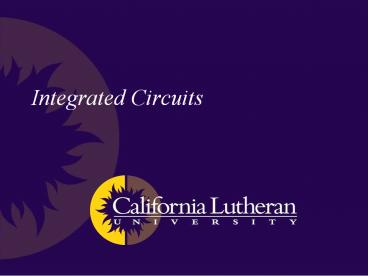Integrated Circuits PowerPoint PPT Presentation
Title: Integrated Circuits
1
Integrated Circuits
2
Integrated Circuit (IC)
- A silicon crystal (chip) containing electronic
components that create the logic gates weve been
looking at - SSI Small Scale Integration
- MSI Medium Scale Integration
- LSI Large Scale Integration
- VLSI Very Large Scale Integration
- These refer to the number of logic gates
contained on the chip
3
Technologies
- TTL Transistor-Transistor Logic
- ECL Emitter-Coupled Logic
- MOS Metal-Oxide Semiconductor
- CMOS Complementary Metal-Oxide Semiconductor
- These refer to the underlying characteristics of
the process for turning silicon into gates
4
Digital Components
- Decoder
- Encoder
- Multiplexer
- Register
- Shift Register
- Counter
- Memory
5
Decoder
- Convert n input bits to a single output bit
- For example converting binary to octal (3-to-8)
- What does the circuit look like?
- Start with a truth table
6
Decoder Chaining
- Decoders can be chained
- Enable bit acts as the 4th input bit
- We now have a 4-to-16 decoder
7
Encoder
- Inverse of a decoder
- Convert one input bit to multiple output bits
- For example converting octal to binary (8-to-3)
8
Multiplexer
- Routes one of 2n input data lines to a single
output line based on n selection lines - How many inputs total?
- How big is the truth table?
9
Multiplexer
- 6 total inputs (4 data lines, 2 selector lines)
leads to 26 64 rows of truth table! - This is excessive and tedious
- More conveniently shown thusly
- Built from an n-to-2n decoder with additional 2n
input data lines
Select Select Output
S1 S0 Y
0 0 I0
0 1 I1
1 0 I2
1 1 I3
10
Multiplexer
I0
I1
Output
I2
I3
Not derived directly from the abridged truth
table but from your knowledge of decoders
S0
S1
11
Register
- A multi-bit storage element made up of a group of
flip-flops - Recall flip-flops store 1 bit each
12
Register
- CLR is a clear input for asynchronous
initialization - Data can be read out at any time
- Data is input with the clock signal, referred to
as loading - Loading can be further controlled through the use
of additional combinational circuitry
13
Shift Register
- Like a normal register only bits can be shifted
from one flip-flop to the next
14
General Purpose Shift Register
- Bidirectional shifting (left and right)
- Serial input/output
- Parallel load
- Parallel output
- A multiplexer is provided to select the operation
15
General Purpose Shift Register
- Multiplexer operation selection
- Use a multiplexer to determine the shift operation
Mode Control Mode Control
S1 S0 Operation
0 0 No Change
0 1 Shift Right
1 0 Shift Left
1 1 Parallel Load
16
General Purpose Shift Register
- What are they good for?
- Integer multiplication by powers of 2
- Integer division by powers of 2
- Bit counting for parity
- etc.
17
Counter
- A register that cycles though predetermined
states based on an external input - Weve seen these already
- You should already know how to design one of
these - Parallel load/clear functionality is often added
via combinational circuitry
18
Memory
- A group of storage cells and associated access
circuits - Bits are grouped into words
- Words are the smallest addressable unit
- Typically made up of 1 or more bytes (8-bits)
- Each word in memory is assigned a unique address
19
Memory
20
Memory
- How many address lines?
- How many data input lines?
- How many data output lines?
21
Memory
- K Kilo-bytes 210 bytes
- M Mega-bytes 220 bytes
- G Giga-bytes 230 bytes
- May be specified in either bytes or words
- Micro-processors will often talk of Kilo-bits
or Mega-bits - Be careful
22
Memory Read/Write
- Read
- Apply binary address on the address lines
- Apply a signal to the read input
- Data is available on the data output lines
- Write
- Apply binary address on the address lines
- Apply binary data to the data input lines
- Apply a signal to the write input
23
Memory
- Two types
- RAM Random Accessible Memory
- Operations we just looked at
- ROM Read Only Memory
- Has no input data lines
- Has no write input
- Has no read input (doesnt need it just acts
when a valid address is supplied)
24
ROM
- Significantly cheaper than RAM since it lacks
versatility - How does the data get in there?
- Mask programming data is programmed in at the
time of silicon fabrication - PROM special programming devices allow the user
to write data one time - EPROM data is erased under ultra-violet light
or electronically, but must be entirely erased
and rewritten (cant write single words)
25
To Do
- Read chapter 2, if you havent already
- Problems 2-1, 2-3, 2-6, 2-7, 2-8, 2-12, 2-13,
2-14, 2-16, 2-19, 2-20 - Assembly language
- A sequence of ASCII characters are stored in
memory (you choose where) - The length of the sequence is stored in register
R0 - See next page for picture
26
Example initial set up
27
To Do
- Assembly language (continued)
- Write an 8051 program to determine if the
sequence is a palindrome - The output will be
- R1 0 if the value is not a palindrome
- R1 1 if the value is a palindrome
- Test your code on various sequences (both even
and odd lengths, palindromes and not palindromes) - Read chapter 4

